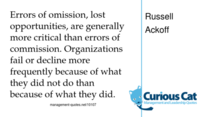Posts selected fromManagement Blog - Engineering Blog - Investing Blog and other blogs - Quality Customer Focus
Kano model of Customer Satisfaction: Kano saw three types of customer satisfaction: required (basic quality also threshold requirements), more is better (performance quality) and delighter (excitement quality).
Customers expectations change over time. Often what was once enough to delight a customer (remote control for a TV) becomes expected... continue reading: Quality Customer Focus - John Simpson
 This is the best I can do to create my Simpson self. Until I have a guest appearance on the show, I guess this will have to do. continue reading: John Simpson - Visible Data
Take the time to find the important measures and then don’t keep data hidden in some drawer or computer file out of people’s view and therefore out of mind. Post the important data for everyone to see. Review the data as changes are made and see that the changes had the desired result. Update the measures when appropriate... continue reading: Visible Data - Visible Data
Take the time to find the important measures and then don’t keep data hidden in some drawer or computer file out of people’s view and therefore out of mind. Post the important data for everyone to see. Review the data as changes are made and see that the changes had the desired result. continue reading: Visible Data - Performance Appraisal Problems
- Toyota Special Report: Thinking Production System
This short article is peppered with many great quotes as section headers:
- In TPS, the T also stands for Thinking
- To cut lead-time, cut out all the bits that don't add value.
- The line must stop if there is a problem.
- Ask yourself Why? five times.
- Develop people who can come up with unique ideas.
continue reading: Toyota Special Report: Thinking Production System - Organization, Systems and Culture
Management improvement is mainly about using great ideas that have been around for years and decades.
Useful, innovative new management ideas are great. But far too much effort is placed in trying to package "systems" (or copyrighted terms) as some new breakthrough in management when most often they offer little of value. continue reading: Organization, Systems and Culture - Toyota Special Report: Thinking Production System
Minoura warns “simply introducing kanban cards or andon boards doesn’t mean you’ve implemented the Toyota Production System, for they remain nothing more than mere tools. The new information technologies are no exception, and they should also be applied and implemented as tools.”
Early in his career, Minoura worked under Taiichi Ohno, recognized as the creator of the Toyota Production System. Ohno, through tireless trial and error, managed to put into practice a “pull” system that stopped the factory producing unnecessary items. But Minoura observes that it was only by developing this “loose collection of techniques” into a fully-fledged system, dubbed the Toyota Production System or TPS, that they were able to deploy this throughout the company continue reading: Toyota Special Report: Thinking Production System - Learning, Systems and Improvement

Errors of omission, lost opportunities, are generally more critical than errors of commission. Organizations fail or decline more frequently because of what they did not do than because of what they did.
Russel Ackoff continue reading: Learning, Systems and Improvement - Learning, Systems and Improvement
Errors of omission, lost opportunities, are generally more critical than errors of commission. Organizations fail or decline more frequently because of what they did not do than because of what they did.
...
The corrective action is itself the result of a decision. A record of this decision should be made and treated as the original decision. In this way the process can not only yield learning but also learning how to learn.
A record of the entire process (all four steps) should be made and stored for easy access by those who may later be confronted by the need to make a similar type of decision.
Russel Ackoff continue reading: Learning, Systems and Improvement - Change is not Improvement
We trained hard… but it seemed that every time we were beginning to form up into teams we would be reorganized. I was to learn later in life that we tend to meet any new situation by reorganizing; and a wonderful method it can be for creating the illusion of progress while producing confusion; inefficiency, and demoralization.
These lines, from the Satyricon of Petronius written 2,000 years ago…*
* Unfortunately it seems this quote is not actually his. continue reading: Change is not Improvement - Change is not Improvement
The Improvement Guide: the Practical Approach to Enhancing Organizational Performance, is an excellent handbook on making changes that are improvements rather than just a way to create the illusion of progress. The book uses three simple questions to frame the improvement strategy.
- What are we trying accomplish?
- How will we know that a change is an improvement?
- What changes can we make that will result in improvement?
continue reading: Change is not Improvement - Management Excellence
I think the question of what other companies have management practices worth studying is interesting. The answer could be very helpful as others could learn from what those organizations do. There are at least two difficulties in identifying those organizations: 1) defining what set of criteria would indicate successful organizations 2) most often even companies that are doing many things well leave much to be desired... continue reading: Management Excellence - Management Excellence
Most management practices cannot be plugged into any organization and work well. That practice must be applied in a sensible way given the organizational system. Learning how lean ideas (or other good ideas) are applied in varying systems can provide insight into how to integrate ideas for organizational improvement from those applying lean practices. continue reading: Management Excellence - Zero Defects
I do not believe you succeed by declaring your goal to be zero defects. You succeed by creating a culture of never ending improvement, of customer focus, of fact based decision making, of learning, of “empowerment”…
Part of that improvement is reducing variation, reducing defects, implementing smart new mistake proofing but innovation is too. Effectively zero defects is not really achievable in most cases. Defects are largely a matter of definition. As performance improves expectations will often rise. When you eliminate anything you would have called a defect years ago, standards are higher and things that would not have been called defects are no longer acceptable. At some point the system process advances to such a level where zero defects is possible in some cases but in many (say medical care, air transportation, education, computer software, restaurants, government, management consulting, civil engineering, legal services…) I really think it is basically impossible. continue reading: Zero Defects
|